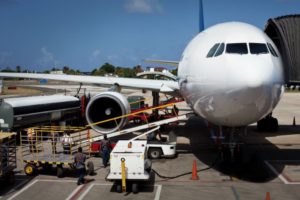Captain Lim Khoy Hing debunks aviation myths and shines light on intriguing little-known facts to ensure you enjoy worry- and guilt-free travels.

Image : Travel 3Sixty
The idea that there is less oxygen at higher altitudes is a myth. In reality, the amount of oxygen in the atmosphere (21 per cent) remains almost the same regardless of the altitude. What actually happens at higher altitudes is that the reduced atmospheric pressure (partial pressure effect) makes it difficult for oxygen to be absorbed into the blood stream. Due to this, the aircraft must be pressurised when flying at higher levels, so that your body is able to absorb about the same amount of oxygen as the plane climbs to cruising altitude.
Calming the Pressure

Image : Travel 3Sixty
Even though you may be cruising at 35,000ft, the aircraft cabin altitude is, in fact, automatically adjusted to simulate a lower one, such as from 6,000 to 8,500ft.
This is achieved through pressurisation. The aircraft cabin is just like a balloon – air from the engine acts like a pump to pressurise the cabin in order to ensure that pressurisation is maintained.
Air Play
The environment inside the cabin is designed with passengers’ comfort in mind. To achieve this, the air-conditioning system uses a mixture of fresh and recirculated engine air to maintain a cozy temperature range.
Due to the restricted space within the aircraft cabin, passengers might mistakenly think that the recirculation of air by the air-conditioning system can cause the spread of viruses. The truth is, cabin air is probably cleaner than the air in a regular office building! Fresh air is drawn from the outside and filtered through hospital-grade filters, which remove 99.97 per cent of bacteria and tiny particles, before it is channelled into the cabin. The plane’s cabin air is refreshed about 15 to 20 times every hour.
On rare occasions, passengers in smaller jets might notice an odour, similar to that of a car’s exhaust gas, shortly after push back from the terminal gate. This is due to the plane’s exhaust gas being drawn into the air-conditioning system. The culprit is usually strong headwinds, causing the air to flow back through the air-conditioning pack inlets, but the good news is that such unpleasant odours quickly disappear.

Image : Travel 3Sixty
And speaking of cabin atmosphere, it’s a fact that cabin air is very dry – containing only about 12 per cent humidity, it is drier than most deserts! Dehydration can make you feel more tired and prone to headaches, and cause increased discomfort when wearing contact lenses. To prevent dehydration, passengers are advised to drink plenty of water, especially on long-haul flights, and to avoid consuming caffeinated beverages, as these have a diuretic effect.
Blue from the Sky
You might have heard stories about ‘blue ice’ or ‘poopsicles’ dropping from the sky, giving the impression that human waste was being indiscriminately dumped from passing planes.
There may have been such occurrences during WWII, when fighter or bomber planes did not have the high-tech flushable toilets that we have in modern aircraft today. In fact, the flight crew would urinate in bottles and dispose of their waste in cardboard boxes! Thankfully, this is no longer the case today.
Incidents of ‘blue ice’, which, in fact, is blue coloured deodorising liquid, only arose with later aircraft. The liquid is purely a cleansing and treatment agent for the waste system, and does not contain any waste mixed in it. Sometimes, these fluids can leak from the plane in mid-flight, and instantly freeze at the bottom of the aircraft. As the fluid continues to leak, more and more ice forms until at one point, it detaches from the plane and drops to the ground – as ‘blue ice’. But rest assured, it does not contain any human waste.
Today, modern airborne waste control technology in your Airbus A320 or A330 is highly efficient. It relies on strong suction to eradicate waste with just a fraction of a gallon of water. The waste is then accumulated in special tanks in the plane, and is sanitised and deodorised. After the aircraft lands, the waste is taken to a treatment facility for processed disposal. Passengers can rest easy in the knowledge that toilet waste has never been disposed from commercial planes in mid-flight; only water from the sinks is dumped directly through the drain mast into the atmosphere.

Image : Travel 3Sixty
After the aircraft lands, waste material is offloaded for proper disposal.
Cabin Delight
With increased air travel worldwide and more passengers than ever before jet setting about, it makes good sense to pay even greater heed to environmental sustainability.
So, the next time you feel a drop on your head when a plane passes by, you can be sure that it isn’t something that has been flushed by a passenger on board! And when you are on a plane, you can be sure that your call of nature will be taken care of discreetly and safely when you reach your destination.
Happy travelling!
Posted: 23.02.18